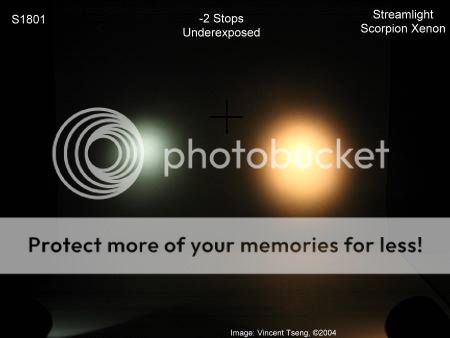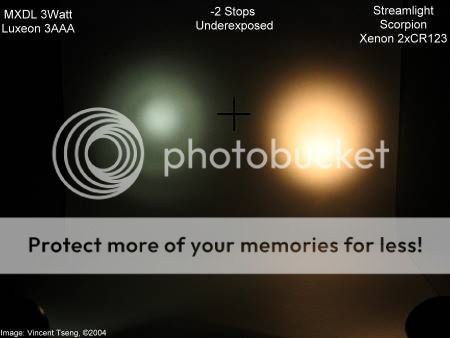You are using an out of date browser. It may not display this or other websites correctly.
You should upgrade or use an alternative browser.
You should upgrade or use an alternative browser.
Luxeon oe Xenon, which more white beam?
- Thread starter Adriano
- Start date
 Help Support Candle Power Flashlight Forum
Help Support Candle Power Flashlight Forum
IsaacHayes
Flashlight Enthusiast
Luxeon will be whiter. Xenon can be if driven hard but will burn out sooner, luxeon will last practically a lifetime. Also when batteries get weaker, xenon will turn yellow-orange light. Luxeon will just get dimmer but still be "pure" white.
LightObsession
Flashlight Enthusiast
- Joined
- Nov 12, 2004
- Messages
- 1,385
I don't know which is whiter, but I prefer the ouput and color of my Brinkman Maxfire xenon much better than any of my LED lights. BTW, 1w is my brightest Luxeon.
[ QUOTE ]
Adriano said:
hello, I'd like to know which bulb produces a more white beam between Luxeon or Xenon.
[/ QUOTE ]
Luxeon will produce a whiter beam - the Xenon although very bright is definitely yellow in comparison -
here are a couple of comparative beamshots:
I've used the -2 Stops Underexposed versions to emphasize the beam colors:
Comparing a Xenon (2x CR123) Streamlight Scorpion to a nice 1watt Luxeon S1801 (1x CR123)

more detailed info -
S1801 1w Luxeon 1xCR123
Xenon Scorpion vs 3watt Chinese "luxeon"-copy MXDL (3x AAA)from eBay -

more detailed info
MXDL 3Watt "Luxeon" 3AAA from eBay
Hope that helps.
Adriano said:
hello, I'd like to know which bulb produces a more white beam between Luxeon or Xenon.
[/ QUOTE ]
Luxeon will produce a whiter beam - the Xenon although very bright is definitely yellow in comparison -
here are a couple of comparative beamshots:
I've used the -2 Stops Underexposed versions to emphasize the beam colors:
Comparing a Xenon (2x CR123) Streamlight Scorpion to a nice 1watt Luxeon S1801 (1x CR123)

more detailed info -
S1801 1w Luxeon 1xCR123
Xenon Scorpion vs 3watt Chinese "luxeon"-copy MXDL (3x AAA)from eBay -

more detailed info
MXDL 3Watt "Luxeon" 3AAA from eBay
Hope that helps.
LEDependent
Enlightened
That would probably be due to the blue paint on a lot of those bulbs /ubbthreads/images/graemlins/grin.gif
asdalton
Flashlight Enthusiast
The typical high-quality xenon lamp will have a whiter and more consistent tint than the average Luxeon. However, the best Luxeons are whiter than incandescent lamps. The days of dreaded "urine green" Luxeons are mostly gone in high-quality flashlights; however, varying degrees of blue are still common.
I have found that you can judge the tint of an LED by comparing it side by side to a bright incandescent beam. If the LED beam has too much blue in it, you will always notice that blue component when comparing the LED and incandescent beams. In that case, the incandescent beam will look whiter. But if you have an LED with a good tint, then the LED beam will look pure white and the incandescent beam will look yellowish.
Interestingly, the incandescent lamp's limitations in efficiency and tint are mainly a limitation of materials rather than of basic physics. If we had a metal that could be heated up to, say 6000 K without melting, then we could get sunlight-pure white light at a lumen efficiency much better than today's best LEDs. But unfortunately, the best that we have is tungsten, which melts at 3695 K.
I have found that you can judge the tint of an LED by comparing it side by side to a bright incandescent beam. If the LED beam has too much blue in it, you will always notice that blue component when comparing the LED and incandescent beams. In that case, the incandescent beam will look whiter. But if you have an LED with a good tint, then the LED beam will look pure white and the incandescent beam will look yellowish.
Interestingly, the incandescent lamp's limitations in efficiency and tint are mainly a limitation of materials rather than of basic physics. If we had a metal that could be heated up to, say 6000 K without melting, then we could get sunlight-pure white light at a lumen efficiency much better than today's best LEDs. But unfortunately, the best that we have is tungsten, which melts at 3695 K.
Similar threads
- Replies
- 18
- Views
- 429
- Replies
- 8
- Views
- 410
